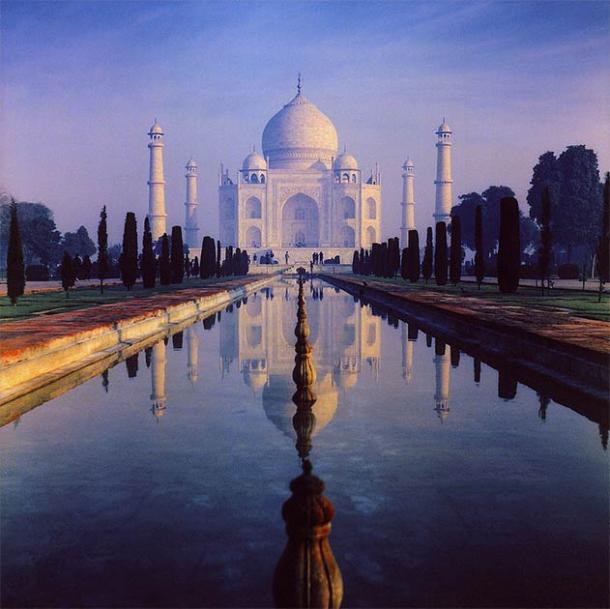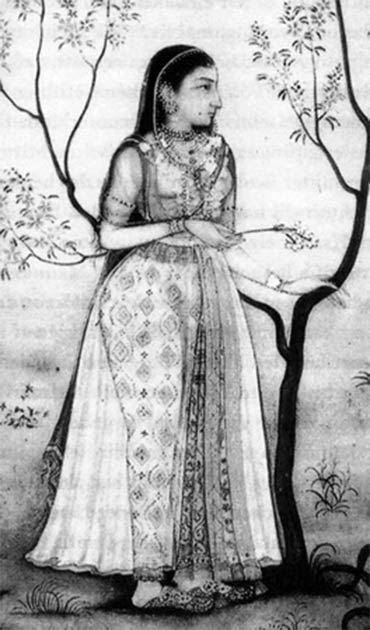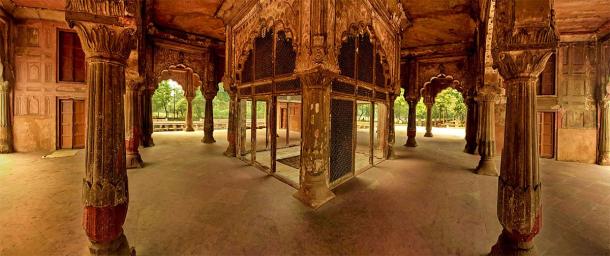The Mughal Empire has been filled with remarkable women , but the most understated of them are two princesses – two sisters – who played a very crucial role during the reign of Shah Jahan and the war of succession. Princess Jahanara was the apple of her father’s eye, loved by all. Very few people had anything bad to say about her and much of what we know comes from Jahanara’s own writings. Therefore, we need to take all that is said with a pinch of salt. On the other hand, her sister Roshanara is elusive within the annals of Mughal history , wherever she is mentioned it is as a schemer, a slut or a disappointment. Both princesses had a crucial part to play in shaping the Mughal empire, from the time of their birth until the end of their life. Complete opposites of one another, Jahanara and Roshanara had a very complex relationship.

Jahanara and Roshanara were the daughters of Mughal emperor Shah Jahan and his favorite wife, Mumtaz Mahal. ( CC BY-SA 3.0 )
Love Children: Birth of the Mughal Princesses
Prince Khurram (later Shah Jahan ) married Arjumand Banu (later Mumtaz Mahal) in 1612, in a union based on love rather than political need. Even though Khurram had several other wives, Arjumand would always be his favorite. It was into this loving environment that the couple’s first child, Princess Jahanara was born, on the 23 rd of March 1614. The young princess was joyously received and welcomed by her parents and the royal household.
It wouldn’t be long before Arjumand was pregnant again and only a year later gave birth to a son, Dara Shikoh. The couples fourth child was another girl, princess Roshanara; a sister, who many believed would be a friend and companion to her older sister in the future. Unfortunately, the lives of the sisters were destined to be filled with hurdles and challenges that would always pit them at odds against one another.

Idealized depiction of life in the Mughal harem, where Jahanara and Roshanara spent most of their lives. ( Public domain )
On the Run from the Mughal Army
Prince Khurram had been his father’s favorite. Jahangir even granted him the title of crown prince and allowed him to pitch the red tent, confirming the title of crown prince. However, circumstances changed and in 1622 Khurram fell from favor, which drastically transformed his family’s fortunes. In order to survive in this uncertain environment, Khurram went on the run accompanied by his favorite wife, Arjumand, who insisted on staying with her husband. This would have meant that her children were also forced to go on the run, and Jahanara, who was just eight years old at the time, would have seen her whole world change. The comforts and pleasure of the harem were replaced by the confines and restraints of the camp.
Mughal women always had to be veiled, which meant that her movement would have been greatly restricted. This change would have had a profound impact upon Jahanara, who learnt that fortunes could rise and fall without warning. For four years Prince Khurram and his family were chased by the Mughal army that was led by General Mahabat Khan. It wasn’t until the end of 1626, when Shah Jahan reconciled with Jahangir, that the Mughal army finally gave up the chase.
In order to ensure that Khurram would not rebel again, Jahangir suggest that he send two sons, Dara and Aurangzeb to court. This led to a temporary separation for the family, but didn’t last for long. In 1628, only two years after Prince Khurram’s pardon, Jahangir passed away. Khurram’s supporters used this opportunity to help the young prince ascend the throne of the Mughal Empire, adopting the title of Shah Jahan and taking his rightful place as the head of the Empire.

Shah Jahan, father to Jahanara and Roshanara, ascended to the throne in 1628. In the image he is depicted with his three eldest sons during his accession ceremony. ( Public domain )
World of the Harem: Prisoners within Gilded Cages
With their father Shah Jahan firmly placed on the throne, Jahanara and Roshanara would have happily returned to their luxurious life in the palace, where female attendants and eunuchs would dote on their every command. Arjumand, now Mumtaz Mahal, would have been at the head of the harem, making sure that all the rules were being followed. In this new world, the young princesses quickly learned the complex rules that governed the harem, which was like a sprawling small city. Each woman was assigned an apartment based on rank. As princesses of Shah Jahan’s favorite wife, Jahanara and Roshanara would have been given every comfort.
Tutors would have been employed in order to educate the young princesses in subjects such as astronomy, poetry, mysticism and mathematics. Records say that Jahanara was a renowned poet, who composed many poems. Within the harem, the women would listen to music and watch dances performed by female troupes. They even took part in falconry, hunting (Nur Jahan was a great hunter and her skill with the gun is legendary), and polo matches. Entertainment came in the form of fireworks and in hearing stories about magic and superstition. Life may sound idyllic, but the women were barred from the outside world, prisoners within gilded cages.
The young princess faced many restrictions when it came to marriage, but it is believed that Jahanara may have fallen in love and even confided her feeling with her mother. Unfortunately, all good things come to an end. For Jahanara and her sister that day came when their mother died in 1631. Jahanara was seventeen years old when her mother passed away, taking with her the remnants of her the princess’s ideal childhood.

Shah Jahan built the beautiful Taj Mahal in the memory of his wife, Mumtaz Mahal. (amaldla / CC BY-SA 2.0 )
Life After Mumtaz Mahal’s Death
After the death of Mumtaz Mahal, Shah Jahan disappeared from the public eye trying to cope with his grief. It may have been at this moment when Jahanara decided to devote her love and care to her father and to remain unmarried. We know little about Roshanara’s reaction upon her mother’s death, but one can assume that she may have been grieving as well. Shah Jahan built the Taj Mahal in 1632 to house the tomb of his beloved.
Princess Jahanara had always held a special place in her father’s heart. His trust in his daughter became clearer when Jahanara was granted the royal seal and was put in charge of the royal harem, instead of his two remaining wives. The royal seal had always passed from queen to queen; Nur Jahan had held the seal, and later Mumtaz Mahal would have been given this honor. Jahanara’s importance is described within the writings of Inayat Khan, who explains that “all duties appertaining to Her late majesty were also now entrusted by His Majesty to Her Highness Jahanara Begum. Shah Jahan even granted her half of Mumtaz’s estate, which was estimated to be around 10 million rupees, while distributing the other half among his remaining five children.”
By granting Jahanara the power and privilege that had once been held by a royal wife, instead of passing these responsibilities to his remaining two wives, Shah Jahan caused rumors to spread about an incestuous relationship with his daughter Jahanara. Luckily, Manucci confirms that such rumors were false and had no truth in them. Clearly Shah Jahan had just turned to his eldest daughter during his grief. Unfortunately, Jahanara’s advancement had caused a rift between the sisters. For Roshanara, living in her older sister’s shadow would have been hard, but when the status of her sister increased by leaps and bounds, she began to resent her sister and her father even more.

Jahanara was the favorite of her father Shah Jahan, who nursed her when she was burned. ( Public domain )
Jahanara and Her Life Threatening Burns
In 1644, Jahanara’s delicate and perfumed clothes accidently caught on fire as she was returning to her room. Four maids tried to extinguish the fire, two of them perishing from the burns that they had sustained. Jahanara herself received life-threatening injuries. Shah Jahan ordered all physicians to come and cure his daughter, promising to reward anyone who would be able to save the princess’s life. For months Jahanara lay on her bed, with Shah Jahan nursing her wounds. Remember that men were not allowed to look at the princess, even physicians and doctors could only deal with their patient with a curtain separating the two.
While Jahanara, lay confined on her sick bed, trouble was brewing between Shah Jahan and his son, Aurangzeb. Hearing of his sister’s injury, Aurangzeb rushed to Agra to visit her. It was during his visit that he was dismissed from his office and humiliated by his father. Disillusioned and angry Aurangzeb left the court. For four months, Jahanara lay at death’s door and it was during this time that Shah Jahan neglected his duties and spent most of his time praying by her bedside. Jahanara eventually recovered. In celebration her weight in gold was then distributed upon the poor and festivities were held in the palace. It seemed like the difficult days were finally over, but little did they know that slowly a great storm was approaching that would engulf the royal household.

Depiction of the Battle of Samugarh in 1658, which was decisive in the Mughal war of succession between the sons of Shah Jahan while he was unwell. During the battle Dara fought against Aurangzeb and Murad. ( Public domain )
Sibling Rivalry: Shah Jahan’s Sons Drift Apart
In 1657 Shah Jahan fell ill, causing panic in the imperial palace. During his recuperation, Jahanara and her brother Dara were by his side. As the days progressed, Shah Jahan didn’t show any sign of getting better. It was during these initial days that princess Roshanara, who had a close relationship with her brother Aurangzeb, claimed that she overheard Jahanara and Dara plotting against their brother due to the threat he posed to the throne. Apparently the plan was to convince Shah Jahan to invite Aurangzeb to the palace and arrange for his assassination. Sibling rivalry came to mark the family as the rift caused by these struggles grew deeper.
Roshanara wrote a letter to Aurangzeb, warning him of the danger that awaited him if he came to Agra and asking him to turn back. Forewarned, Aurangzeb turned against his father, altered his plans and went to join forces with his brother Murad. Shah Shuja, another of their brothers, had already declared himself emperor. In order to dissuade his sons, Shah Jahan declared Dara as his successor. Unfortunately, the damage had been done.
The dark clouds of rebellion were now on the horizon. Shah Jahan’s attempt to exterminate Aurangzeb had signaled the start of the war. In this climate of turmoil, sides had to be chosen; Jahanara chose to the side with her brother Dara and her father, while Roshanara decided to side with Murad and Aurangzeb. This rift between the siblings caused major disorder in the country. As time went on, Shah Jahan recovered from his illness and attempted to stop his sons. But when talks aiming for peace didn’t succeed, he proposed dividing the empire equally among his four sons.
All those involved were children born from the same mother. This was unique, since previously fights had erupted between the sons of different queens. In this scenario, no matter who took the throne, they would each suffer grief because they were fighting their own flesh and blood. Jahanara, had initially tried to persuade her brothers to stop their fighting. Their father was now well and the siblings would now be fighting not just against each other, but their father as well.
However, her cries fell on deaf ears. The war was fought and among the four brothers only one, Aurangzeb, emerged victorious. Aurangzeb knew the threat that his brothers posed, therefore he had Dara executed and his other two brothers blinded. His last act was to imprison his father in the fort at Agra, which lay next to the Taj Mahal .

The passing of Shah Jahan with Jahanara by his side. ( Public domain )
Aftermath: What Happened Next for Jahanara and Roshanara?
Jahanara, who had once been the head of the harem, was replaced by her younger sister, Roshanara; it was her reward for siding with Aurangzeb. Jahanara devoted her life to taking care of her father and lived with him until his death. Both father and daughter grieved the loss of Dara, who they had tried to save but failed. In her memoirs she remembers her brothers and from her words you can tell how she feels about them. About Dara she writes: “Dear to me was my brother Dara: ever was I true to him. And he was true to the great dream of our glorious ancestor, Akbar.” Regarding Aurangzeb she continues: “Woe unto thee, Aurangzeb! A man struck by Fate thou didst crush under foot; and, calling him godless, thou didst take his life!” In other words, Jahanara held her brother Dara, in high regards, whereas she did not share the same love towards Aurangzeb.
Roshanara did not leave behind any writings, but it is known that she established a very firm grip in the harem and the wives of Aurangzeb began to resent her power. Rumors began to spread that Roshanara had started keeping lovers. We know very little about her before the war of succession, so this description by Jahanara seems fairly drastic. In any case, her behavior began to disturb the religious sensibilities of her brother, Aurangzeb.
In 1666 tragedy stuck when Shah Jahan passed away. A very distraught Jahanara arranged her father’s funeral but could not make it grand because Aurangzeb wouldn’t allow it. However, upon his father’s death, Aurangzeb wanted to reconcile with his older sister because he still loved and respected her. He even granted Jahanara control of the harem, a move that caused considerable distress for Roshanara who died in 1671. Even though she had been the main supporter of Aurangzeb, many accounts claim she was poisoned by him. She died a miserable death, her body swollen like a hogshead. Jahanara lived on for ten years, dying peacefully in 1681.

While there is little in the historic record about Roshanara, her garden and tomb can still be visited today in Delhi. After falling out with her brother Auragzeb, she was banished to these gardens and was buried here after her death in 1671. (Prayash Giria / CC BY-SA 3.0 )
Princess Jahanara’s Legacy
Jahanara left a legacy thanks to her many contributions in architecture, poetry and other arts. However, there is very little mention of Roshanara’s achievements, besides her gardens in New Delhi where she was banished after her fall from favor and where she was buried after her death.
Despite new royal responsibilities, Jahanara learned from Nur Jahan and her mother’s example; taking part in indigo and cloth trade that helped her make a profit. She even began distilling her own special wine, to which she would add rose water. The wine was said to have been so special that she would gift it to important dignitaries. Jahanara was also able to commission the construction of several mosques and gardens. The most famous of Jahanara’s creations was Chandni Chowk, a marketplace which was filled with vendors.
Jahanara and her brother Dara were very religious. Of Jahanara Michael H. Fisher writes, “combining her religious and literary commitments, she had herself initiated into the Qadri Sufi order and wrote an account of Qadir pir Shah Badakhshi, entitled Risala-I Sahabiyya, which included a dozen of her own verses. Similarly, she was deeply devoted to the Chishti order, writing a biography of Khwaja Mu‘in-ud-Din, entitled Mu‘nis-al- Arwah.”
Both princesses were human, and like everyone each had their flaws and their strengths. Their lives were filled with many ups and downs, yet each faced the challenges with courage and bravery. Jahanara loved life; she enjoyed drinking wine and immersed herself in the Sufi faith. On the other hand, Roshanara’s early life is a mystery, while she is portrayed negatively when she rose to power. History has remembered one sister favorably, while the other has been regarded as a harlot. While both made mistakes, they should be remembered as poets and architects, who made contributions that have kept their names alive through the ages.
Top image: Jahanara and Roshanara were rival princesses and daughters of Shah Jahan, who built the Taj Mahal in memory of his wife and their mother, Mumtaz Mahal. Source: Kalyakan / Adobe Stock
Related posts:
Views: 0
 RSS Feed
RSS Feed
















 November 22nd, 2020
November 22nd, 2020  Awake Goy
Awake Goy  Posted in
Posted in  Tags:
Tags: 
















